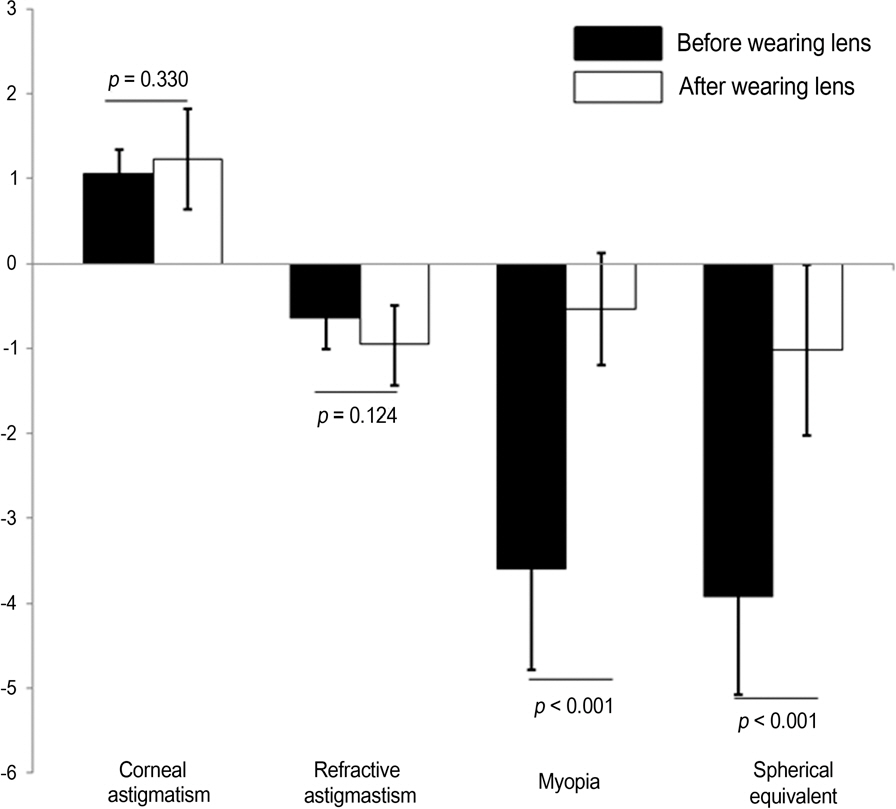J Korean Ophthalmol Soc.
2015 Jul;56(7):980-984. 10.3341/jkos.2015.56.7.980.
Effect of Toric Orthokeratology Lenses in Patients with Limbus to Limbus Corneal Astigmatism
- Affiliations
-
- 1Department of Ophthalmology, Pusan National University School of Medicine, Busan, Korea. Jiel75@hanmail.net
- 2YK Eye Clinic, Seoul, Korea.
- 3Research Institute for Convergence of Biomedical Science and Technology, Pusan National University Yangsan Hospital, Yangsan, Korea.
- KMID: 2148795
- DOI: http://doi.org/10.3341/jkos.2015.56.7.980
Abstract
- PURPOSE
To report the efficacy of toric orthokeratology lenses in patients with astigmatism within 1.5 D having difficulty in wearing spherical orthokeratology lenses due to the limbus-to-limbus corneal astigmatism.
METHODS
Twenty-three eyes of 16 patients with limbus-to-limbus corneal astigmatism who had been wearing toric orthokeratology lenses for more than 6 months were recruited. The uncorrected visual acuity (UCVA), refractive error, and keratometric changes including eccentricity before and after wearing lenses were compared, and the correlations between corneal astigmatism as well as refractive astigmatism and lens toricity were assessed.
RESULTS
After wearing the lens, UCVA (log MAR) significantly improved from 0.61 +/- 0.22 to 0.05 +/- 0.08 (p < 0.001). Myopia and spherical equivalent were also reduced significantly (p < 0.001 and p < 0.001, respectively). While Simulated K (Sim K) tended to be more flattened (p < 0.001) and the eccentricity showed significant decrease (p < 0.001), corneal and refractive astigmatism were not changed significantly (p = 0.330 and p = 0.124, respectively). Correlations between corneal and refractive astigmatism and lens toricity were not statistically significant (r = 0.244, p = 0.300; r = -0.051, p = 0.832). No patients showed lens decentration or visual discomfort.
CONCLUSIONS
Corneal topography was essential in patients who had difficulty in wearing spherical orthokeratology lenses due to the limbus-to-limbus corneal astigmatism. Toric orthokeratology lenses may be an effective treatment option in patients with limbus-to-limbus corneal astigmatism.
Keyword
Figure
Cited by 1 articles
-
Comparative Effect of Spectacles and Orthokeratology Lenses on Axial Elongation in Children with Mild-to-Moderate Myopia
Tae Hee Kim, Myung Hun Kim, Joo Young Kwag, Jin Seok Choi, Kyu Hong Pak, Kyeongwook Lee, Taeseong Park, Sung Kun Chung, Joo Hyun
J Korean Ophthalmol Soc. 2018;59(11):1009-1016. doi: 10.3341/jkos.2018.59.11.1009.
Reference
-
References
1. Grosvenor T, Perrigin DM, Perrigin J, Maslovitz B. Houston Myopia Control Study: a randomized clinical trial. Part II Final re-port by the patient care team. Am J Optom Physiol Opt. 1987; 64:482–98.2. Chung K, Mohidin N, O’Leary DJ. Undercorrection of myopia en-hances rather than inhibits myopia progression. Vision Res. 2002; 42:2555–9.
Article3. Grosvenor T, Perrigin J, Perrigin D, Quintero S. Use of siliconea-crylate contact lenses for the control of myopia: results after two years of lens wear. Optom Vis Sci. 1989; 66:41–7.
Article4. Chua WH, Balakrishnan V, Chan YH. . Atropine for the treat-ment of childhood myopia. Ophthalmology. 2006; 113:2285–91.
Article5. Cho P, Cheung SW. Retardation of Myopia in Orthokeratology (ROMIO) Study: a 2-year randomized clinical trial. Invest Ophthalmol Vis Sci. 2012; 53:7077–85.
Article6. Cheung SW, Cho P. Subjective and objective assessments of the ef-fect of orthokeratology-a cross-sectional study. Curr Eye Res. 2004; 28:121–7.7. Chan B, Cho P, Cheung SW. Orthokeratology practice in children in a university clinic in Hong Kong. Clin Exp Optom. 2008; 91:453–60.
Article8. Cheung SW, Cho P, Chan B. Astigmatic changes in orthokera-tology. Optom Vis Sci. 2009; 86:1352–8.
Article9. Park YK, Lee JS, Lee JE. Correction of limbus-to-limbus corneal astigmatism with toric orthokeratology lenses. J Korean Ophthalmol Soc. 2013; 54:502–7.
Article10. Pauné J, Cardona G, Quevedo L. Toric double tear reservoir con-tact lens in orthokeratology for astigmatism. Eye Contact Lens. 2012; 38:245–51.
Article11. Choi JH, Ryu JW, Lee YC, Kim HS. An analysis of correlation with visual acuity, refractive error and corneal astigmatism after wearing of reverse geometry lenses. J Korean Ophthalmol Soc. 2006; 47:1266–73.12. Kawamorita T, Uozato H, Kamiya K. . Repeatability, reprodu-cibility, and agreement characteristics of rotating Scheimpflug photography and scanning-slit corneal topography for corneal power measurement. J Cataract Refract Surg. 2009; 35:127–33.
Article13. Jain R, Dilraj G, Grewal SP. Repeatability of corneal parameters with Pentacam after laser in situ keratomileusis. Indian J Ophthalmol. 2007; 55:341–7.14. Kleinstein RN, Jones LA, Hullett S. . Refractive error and eth-nicity in children. Arch Ophthalmol. 2003; 121:1141–7.
Article15. Bourne RR, Dineen BP, Ali SM. . Prevalence of refractive error in Bangladeshi adults: results of the National Blindness and Low Vision Survey of Bangladesh. Ophthalmology. 2004; 111:1150–60.16. Cho P, Cheung SW, Edwards M. The longitudinal orthokeratology research in children (LORIC) in Hong Kong: a pilot study on re-fractive changes and myopic control. Curr Eye Res. 2005; 30:71–80.
Article17. Mountford J.An analysis of the changes in corneal shape and re-fractive error induced by accelerated orthokeratology. Int Contact Lens Clin. 1997; 24:128–44.
Article18. Soni PS, Horner DG. Clinical contact lens practice. 1st. Philadelphia: JB Lippincott;1993. p. 1–7.19. Joe JJ, Marsden HJ, Edrington TB. The relationship between cor-neal eccentricity and improvement in visual acuity with orthokeratoloy. J Am Optom Assoc. 1996; 67:87–97.20. Yun YM, Kim MK, Lee JL. Change of corneal parameters after re-moving reverse geometry lens in moderate degree myopia. J Korean Ophthalmol Soc. 2005; 46:1478–85.21. Chen C, Cho P. Toric orthokeratology for high myopic and astig-matic subjects for myopic control. Clin Exp Optom. 2012; 95:103–8.
Article22. Chen CC, Cheung SW, Cho P. Toric orthokeratology for highly as-tigmatic children. Optom Vis Sci. 2012; 89:849–55.
Article23. Sanders DR, Koch DD. An atlas of corneal topography. 1st. New Jersey: Slack Incorporated;1993. p. 5563.
- Full Text Links
- Actions
-
Cited
- CITED
-
- Close
- Share
- Similar articles
-
- Correction of Limbus-to-Limbus Corneal Astigmatism with Toric Orthokeratology Lenses
- Effect of Toric Orthokeratology Lenses on Patients with More Than 1.5 Diopter of Corneal Astigmatism
- The Effect of Astigmatism Correction in Myopic Astigmatism by Toric Lenses: Comparison with Hard Contact Lenses
- Astigmatic Changes after 6mm Scleral Tunnel Incisions at 1mm and 2.5mm from the Limbus in Sutureless Cataract Surgery
- Clinical Characteristics of Prescribing Orthokeratology Lenses in Adult





